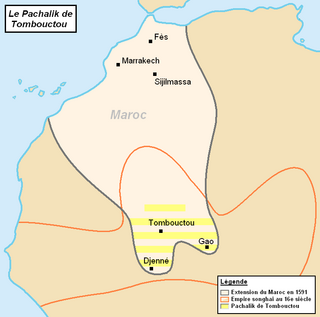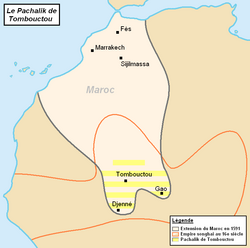
Timbuktu is a city in Mali, situated 20 kilometres north of the Niger River. The town is the capital of the Tombouctou Region, one of the eight administrative regions of Mali, having a population of 54,453 in the 2009 census.

The Songhai Empire was a state located in the western part of the Sahel during the 15th and 16th centuries. At its peak, it was one of the largest African empires in history. The state is known by its historiographical name, derived from its largest ethnic group and ruling elite, the Songhai people. Sonni Ali established Gao as the empire's capital, although a Songhai state had existed in and around Gao since the 11th century. Other important cities in the kingdom were Timbuktu and Djenné, where urban-centred trade flourished; they were conquered in 1468 and 1475, respectively. The Akan state of Bonoman was located to the south of the empire. Initially, the Songhai Empire was ruled by the Sonni dynasty, but it was later replaced by the Askia dynasty (1493–1901).

The Songhai people are an ethnolinguistic group in West Africa who speak the various Songhai languages. Their history and lingua franca is linked to the Songhai Empire which dominated the western Sahel in the 15th and 16th century. Predominantly adherents of Islam, the Songhai are primarily located in Niger and Mali within the Western Sudanic region. Historically, the term "Songhai" did not denote an ethnic or linguistic identity but referred to the ruling caste of the Songhay Empire known as the Songhaiborai. However, the correct term used to refer to this group of people collectively by the natives is "Ayneha". Although some Speakers in Mali have also adopted the name Songhay as an ethnic designation, other Songhay-speaking groups identify themselves by other ethnic terms such as Zarma or Isawaghen. The dialect of Koyraboro Senni spoken in Gao is unintelligible to speakers of the Zarma dialect of Niger, according to at least one report. The Songhay languages are commonly taken to be Nilo-Saharan but this classification remains controversial: Dimmendaal (2008) believes that for now it is best considered an independent language family.

Askia Muhammad I (1443–1538), born Muhammad ibn Abi Bakr al-Turi or Muhammad Ture, was the first ruler of the Askia dynasty of the Songhai Empire, reigning from 1493 to 1528. He is also known as Askia the Great, and his name in modern Songhai is Mamar Kassey. Askia Muhammad strengthened his empire and made it the largest empire in West Africa's history. At its peak under his reign, the Songhai Empire encompassed the Hausa states as far as Kano and much of the territory that had belonged to the Songhai empire in the east. His policies resulted in a rapid expansion of trade with Europe and Asia, the creation of many schools, and the establishment of Islam as an integral part of the empire.

Sunni Ali, also known as Si Ali, Sunni Ali Ber, born Ali Kolon, reigned from about 1464 to 1492 as the first king of the Songhai Empire and as the 15th ruler of the Sunni dynasty. Under Sunni Ali's command, many cities were captured and then fortified, such as Timbuktu and Djenné. Sunni conducted a repressive policy against the scholars of Timbuktu, especially those of the Sankore region who were associated with the Tuareg whom Ali expelled to gain control of the town.
Taghaza is an abandoned salt-mining centre located in a salt pan in the desert region of northern Mali. It was an important source of rock salt for West Africa up to the end of the 16th century when it was abandoned and replaced by the salt-pan at Taoudenni which lies 150 km (93 mi) to the southeast. Salt from the Taghaza mines formed an important part of the long distance trans-Saharan trade. The salt pan is located 857 km (533 mi) south of Sijilmasa, 787 km (489 mi) north-northwest of Timbuktu and 731 km (454 mi) north-northeast of Oualata.

The Saadi Sultanate was a state which ruled present-day Morocco and parts of West Africa in the 16th and 17th centuries. It was led by the Saadi dynasty, an Arab Moroccan Sharifian dynasty.
The Battle of Tondibi was the decisive confrontation in the 16th-century invasion of the Songhai Empire by the army of the Saadi dynasty in Morocco. Though vastly outnumbered, the Moroccan forces under Judar Pasha defeated the Songhai Askia Ishaq II, guaranteeing the empire's downfall.
Diego de Guevara, Yuder Pachá or Judar Pasha was a Muslim Spanish military leader under the Saadian sultan Ahmad al-Mansur in the late 16th century. He led the Saadian army in the conquest of the Songhai Empire.
Askia Ishaq II was ruler of the Songhai Empire from 1588 to 1591.
The Dendi was a former province of the Songhai Empire. It survived the fall of the Empire as a kingdom until 1901, when it was conquered by France and incorporated into French West Africa. Its centers today are the cities of Gaya in Niger, Kamba in Nigeria and Malanville in Benin
The Askiya dynasty, also known as the Askia dynasty, ruled the Songhai Empire at the height of that state's power. It was founded in 1493 by Askia Mohammad I, a general of the Songhai Empire who usurped the Sonni dynasty. The Askiya ruled from Gao over the vast Songhai Empire until its defeat by a Moroccan invasion force in 1591. After the defeat, the dynasty moved south back to its homeland and created several smaller kingdoms in what is today Songhai in south-western Niger and further south in the Dendi.
The University of Timbuktu is a collective term for the teaching associated with three mosques in the city of Timbuktu in what is now Mali: the mosques of Sankore, Djinguereber, and Sidi Yahya. It was an organized scholastic community that endured for many centuries during the medieval period. The university contributed to the modern understanding of Islamic and academic studies in West Africa during the medieval period and produced a number of scholars and manuscripts taught under the Maliki school of thought.
The Arma people are an ethnic group of the middle Niger River valley, descended from Moroccan conquers of the 16th century. The name, applied by other groups, derives from the word ar-rumah "fusiliers".

Askia Ishaq I was the ruler of the Songhai Empire from 1539 to 1549, elected Askia following the death of Askia Isma'il. He was the fifth ruler of the Askiya dynasty which had the town of Gao as its capital.

The Battle of Jenné was a military engagement between forces of the Mali Empire and the Moroccan Pashalik of Timbuktu. The battle marked the effective end of the great Mali Empire and set the stage for a plethora of smaller West African states to emerge.

Starting out as a seasonal settlement, Timbuktu was in the kingdom of Mali when it became a permanent settlement early in the 12th century. After a shift in trading routes, the town flourished from the trade in salt, gold, ivory and slaves from several towns and states such as Begho of Bonoman, Sijilmassa, and other Saharan cities. It became part of the Mali Empire early in the 14th century. By this time it had become a major centre of learning in the area. In the first half of the 15th century the Tuareg tribes took control of the city for a short period until the expanding Songhai Empire absorbed the city in 1468. The Moroccan army defeated the Songhai in 1591, and made Timbuktu, rather than Gao, their capital.

Askia Daoud was the ruler of the Songhai Empire from 1549 to 1582. Daoud came to power unopposed following the death of his brother Askia Ishaq I in 1549. The Empire continued to expand under Daoud's peaceful rule, and saw little internal strife, until the invasion and interference of the Moroccan forces, which led to the empire's downfall in 1591.

The Songhaiborai or Songhayboray are a distinct subgroup within the larger Songhai ethnolinguistic family. Residing predominantly in Niger's Songhai region, Northern Mali, and a minority presence in Burkina Faso. Notably, they trace their lineage to the ruling dynasties of the ancient Songhai Empire.
The Moroccan invasion of the Songhai Empire began with an expedition sent in 1590 by Sultan Ahmad al-Mansur of the Saadian dynasty, which ruled over Morocco at the time. The Saadian army, led by Judar Pasha, arrived in the Niger valley region in 1591 and won its first and most decisive victory against the forces of Askia Ishaq II at the Battle of Tondibi and occupied the capital of Gao shortly after.









